Answer to Question 1
Correct Answer: 1
Rationale 1: The nurse is correct because the nurse is responsible for the care of the client. Other staff members may assist the nurse in obtaining information, but the nurse will need to evaluate the client and report to the physician as necessary.
Rationale 2: The nursing assistant is incorrect because the nurse is responsible for the care of the client. The nursing assistant can notify the nurse of any unusual behaviors or new symptoms for the nurse to evaluate.
Rationale 3: The family of the client is incorrect because the nurse is responsible for the care of the client. The family can notify the nurse of any unusual behaviors or new symptoms for the nurse to evaluate.
Rationale 4: The physical therapist is incorrect because the nurse is responsible for the care of the client. The physical therapist can notify the nurse of any unusual behaviors or new symptoms for the nurse to evaluate.
Global Rationale: The nurse is correct because the nurse is responsible for the care of the client. Other staff members may assist the nurse in obtaining information but the nurse will need to evaluate the client and reporting to the physician as necessary. The nursing assistant is incorrect because the nurse is responsible for the care of the client. The nursing assistant can notify the nurse of any unusual behaviors or new symptoms for the nurse to evaluate. The family of the client is incorrect because the nurse is responsible for the care of the client. The family can notify the nurse of any unusual behaviors or new symptoms for the nurse to evaluate. The physical therapist is incorrect because the nurse is responsible for the care of the client. The physical therapist can notify the nurse of any unusual behaviors or new symptoms for the nurse to evaluate.
Answer to Question 2
Correct Answer: 1, 2
Rationale 1: Right client is one of the six rights of medication administration.
Rationale 2: The right route of administration is one of the six rights of medication administration.
Rationale 3: Right dose is one of the six rights of medication administration.
Rationale 4: The right time of preparation is not one of the six rights of medication administration. The right time of delivery is one of the six rights of medication administration.
Rationale 5: Right documentation is one of the six rights of medication administration.
Global Rationale: The six rights are right client, right medication, right dose, right route of administration, right time of delivery, and right documentation. Right time of preparation is not one of the six rights of medication administration.







